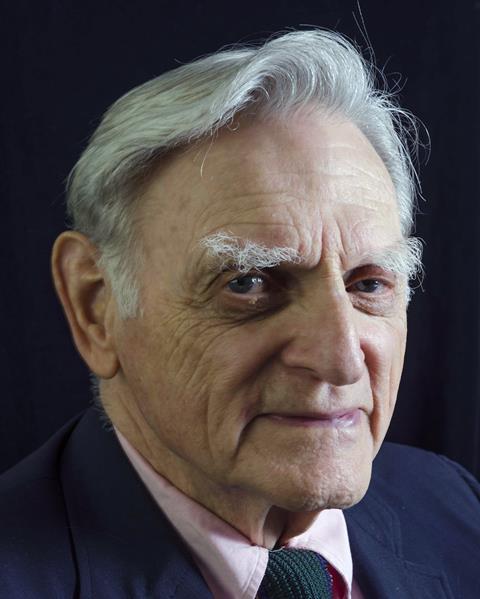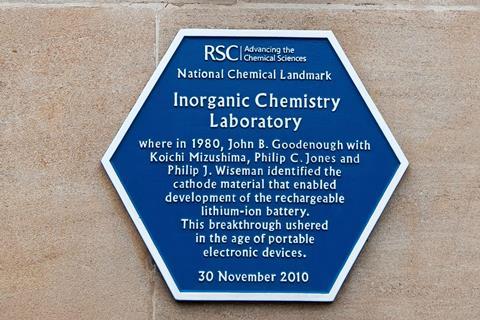
Materials scientist John Goodenough, the inventor of the lithium–ion battery, died on 25 June – just a month shy of his 101st birthday. His pioneering work on the now ubiquitous lithium-ion battery led to him receiving the 2019 Nobel prize in chemistry.
His work helped to spawn the wireless revolution and put electronic devices in the hands of people worldwide, explains the University of Texas, Austin, where he worked for nearly 40 years. Goodenough, who was the oldest recipient of the Nobel prize at 97 years old, shared the award with British–American chemist Stanley Whittingham and Japanese chemist Akira Yoshino.
Goodenough identified and developed cathode materials that made lithium-ion batteries viable and eventually capable of powering electronics like mobile phones, power tools, laptops and tablets, as well as electric vehicles. He also formulated several fundamental rules in magnetism, and identified a ceramic anode material for a solid oxide fuel cell that runs on methane. Unusually, for a top materials scientist he never received any formal chemistry training.
Born in Germany to American parents in July 1922 and raised in the US, Goodenough has said he was dyslexic as a young man and never a very good reader. His undergraduate degree from Yale University was in mathematics. But just before earning that degree, Goodenough was called to active duty and served in the US Army as a meteorologist during the second world war. He was short one course for graduation, but Yale did give him credit for an army meteorology course allowing him to graduate summa cum laude in mathematics in the spring of 1943.
Goodenough subsequently enrolled in the University of Chicago in 1946, ultimately earning a master’s degree and then a PhD in physics. His supervisor there was Nobel laureate Enrico Fermi.
Goodenough’s career began at the Massachusetts Institute of Technology’s (MIT) Lincoln Laboratory in the early 1950s, and he worked there for 24 years. During his time there, Goodenough made important contributions to the development of random-access memory. He was also one of the founders of the modern theory of magnetism, which became the Goodenough–Kanamori rules.
Somewhat scandalous
He moved from MIT to the University of Oxford in 1976 to head the inorganic chemistry lab for a decade. While there, Goodenough focused on electrochemistry, including batteries, carrying out his Nobel-prize winning work.

Russell Egdell, who was doing his PhD at Oxford in 1976 when Goodenough arrived, previously told Chemistry World that the appointment of an American caused something of a ‘scandal’ in the inorganic chemistry community.
Then in 1986, with Goodenough’s retirement from Oxford anticipated, he accepted an offer to become chair of engineering at the University of Texas at Austin. In the US, retirement before age 67 was not required, so he kept working for another 32 years as a materials science and engineering professor.
Goodenough was still teaching and researching battery materials, as well as solid-state science and engineering problems when he won the Nobel prize at 97 years old. His frequent advice to many, including the Nobel Foundation, was: ‘Don’t retire too early’.
In an interview with Chemistry World almost six years ago, he said that his greatest interest outside of science was Christianity, but that travelling also topped the list.
He recollected walking in the Jotunheimen Mountains of Norway when Hitler invaded Poland in 1939, and then down in the Smokey Mountains of Tennessee just before joining the army. He also reported crossing the Rocky Mountains in the US, as well as the French and Austrian Alps, and the Sudeten Mountains in the Czech Republic.
‘In the end, I have had an extraordinary journey, but it is the many colleagues who have worked with me over the years that I wish to thank for making it extraordinary,’ Goodenough wrote in his Nobel prize biography. ‘They are the ones who have performed the experiments and each of them kept an open dialogue with the aim to teach me as much as I tried to teach them.’
More recently, Goodenough dabbled in politics. He was one of more than 80 US science Nobel laureates who signed an open letter endorsing Democrat Joe Biden for president over the incumbent Donald Trump ahead of the 2020 election.
Arumugam Manthiram, who was one of his postdoctoral fellows at Oxford and joined him at UT Austin in the 1980s, said Goodenough’s seven decades in science and technology ‘dramatically altered our lifestyle’. He describes him as ‘humble, thoughtful and curious’, with high moral standards. ‘He is a role model to everyone not only in science, but also in our daily life,’ says Manthiram, who is himself a battery scientist.
Columbia University chemical metallurgy professor Dan Steingart says it is impossible to summarise Goodenough’s contributions. ‘Any scientist that creates 1% of his understanding would consider themselves shockingly fortunate,’ he tells Chemistry World. ‘Actively pushing the boundaries for 100 years, his work heralded both the electronic and the electrochemical eras.’